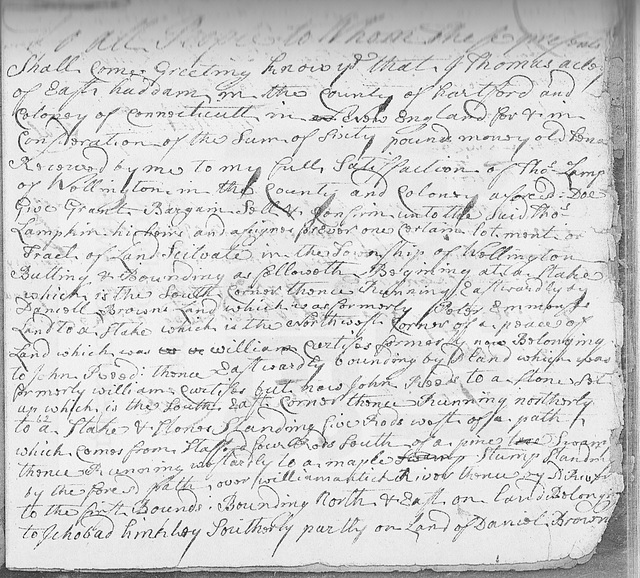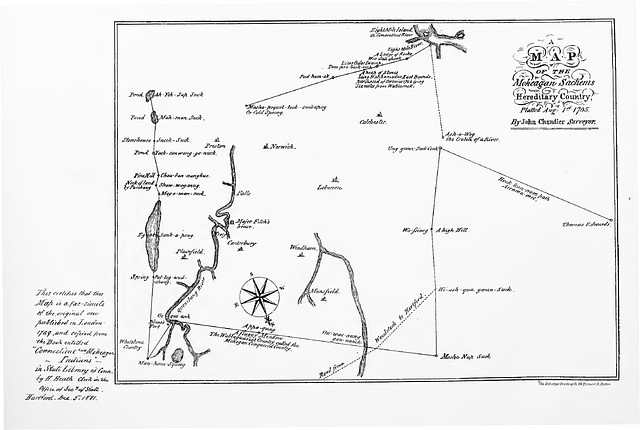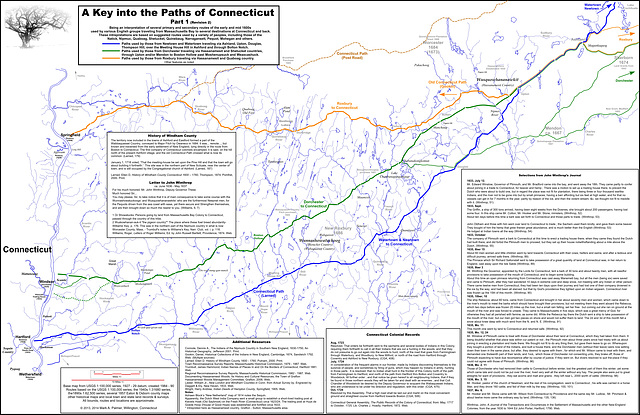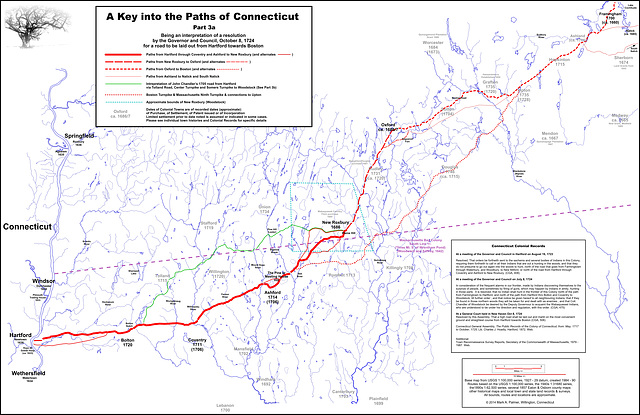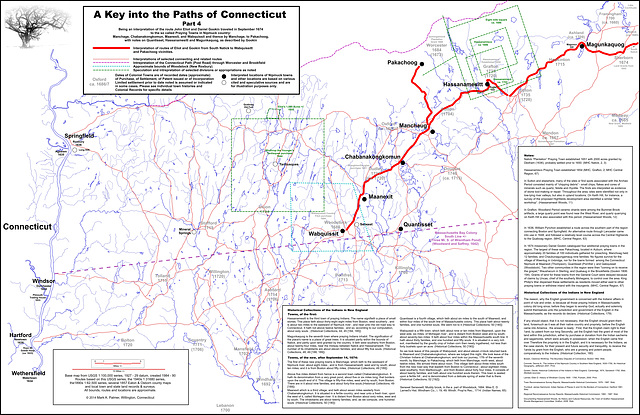
Illustrations
Research and field work.
12 Jul 2013
Parsons, Merick 1739/40
Signed, Sealed and Delivered. Transactions between John Merrick and his neighbor Joseph Parsons in February 1739/40 and some incidental tools.
Spelling in the old records is usually an exercise in creativity, and grammar is nonexistent. So "Merrick" could be written "Merick" or "merrik" or any other possible translation of the oral transmission of information. Road is sometime "Rod" "Rhod" "Rode" etc.
30 Apr 2014
Ford way, Circa 1730 - 1746
First part o a deed from Thomas Acley to Thos Lampkin. Book B - 124.
The description of the bounds starts on the eleventh line with "Butting & Bounding as followeth begining at a stake... ".
This is the third in a series of transactions for a 40 acre parcel of land abutting a fording place on the Willimantic River. The fording place is above (upstream of) where the Center Turnpike bridge crossed the Willimantic River which is just above where the Wilber Cross Parkway of the late 1930s and the present day Interstate I84 crosses the Willimantic River.
The first transaction dated December 11, 1730 is the sale for "thirty six pounds money in hand" by Daniel Eaton of Tolland to Moses Rowley of East Haddam. The second transaction dated April 7, 1732 is a sale by Moses Roulee, now of Middletown for "the sum of forty pounds currant money" to Thomas Acley of Haddom Est. The third transaction dated May 12, 1746 is a sale for "60 pounds old tenar" by Thomas Acley of East Haddam to Thos. Lampkin of Wellington.
The description of the bounds are similar in all three deeds except for some minor changes such as the distance of the second to last bound from the path from Stafford, changing from two rods to five rods and exchanging "path over willimantic" for "ford way".
30 Apr 2014
Ford way, Circa 1730 - 1746 continued.
Second part of a deed from Thomas Acley to Thos Lampkin. Book B - 125.
The business or legal end of the transaction verbiage. Sometimes this end of the document or "instrument" can go a full page with the signature and "seal" running over to another page.
18 Jul 2014
Meeting House Lot
Final plot of the Meeting House lot with associated Town and General Assembly records.
Mention in the General Assembly record of the "highest part of sawins plain" would suggest that the hill circa 1735 was a bare or "bald" hill. The Wabaquasett/Shetucket and perhaps Mohegan were still hunting and fishing in the area at least up until 1724 according to Colonial records. One could speculate that the land was still being fired at least up to that date.
24 Apr 2014
The Mohegan Country, Chandler 1705
A map of the Mohegan Sachems Hereditary Country Plotted Aug 1, 1705 by John Chandler Surveyor. (Bowen, 26)
This map of Mohegan country was done for the 1704 Dudley Commission that was convened to hear the Mohegan challenge of Major John Mason's transfer, as the trustee of Mohegan Reserved Lands, of those lands to the Connecticut government.
Note that north is at the bottom.
This is an important primary source document that helps explain Roger Williams 1637 description of the overland connection between Massachusetts Bay and the Connecticut River valley English settlements.
This map by Chandler places the southwest corner of Wabaquasett Country at Moshe nup suck, the outlet of mishi nippe (present day Shenipsit Pond - mishi-nipe-set, at or near the great pond). Prior to the English war against the Pequot, Wabaquasett Country was part of Shetucket Country, as attested to by Mohegan, Nipmuck Wabaquasett, and Shetucket. The country reportedly extended forty five miles, which if measured from Moshe nup suck would have run to the Blackstone River. From the outlet, Moshe nup suck, to the Connecticut River valley would have most likely been part of several Connecticut River valley communities such as those at or near Hockenum, Podunk and Scantic.
Roger Williams described the route linking Connecticut (ostensibly Hartford and Windsor although it would be valid for Springfield as well) as passing through the Nipnet lands of Hassanemesit and Shetucket countries.
The Hassanemisco and Shetucket were identified as Nipmuc - as differentiated from the Massachusett, in other words, the inland communities as opposed to the coastal communities. Taken at face value, the western bound of the Massachusett could have been Natick, as the compound was used as a bound name. If so, this would suggest that Hassanemesit Country extended from Natick to the Blackstone River. If Hassanemesit and Shetucket countries were so defined, it would explain William's description of the route through the greater Nipmuck Country.
For a comparison, the northwest bound of Wabaquasett Country was called Natick Hill, which could have been a bound between Nipmuck and Connecticut River valley communities near the Freshwater Brook and Chicopee River, as Moshe nup suck would have been for the more southerly Connecticut River valley communities around the Scantic and Hockanum Rivers as noted. The place name Natick shows up in Rhode Island as well.
From early English records concerning the bounds of Native American lands, it would seem that Native American country bounds used pond/lake outlets, hills and rivers to denote the extent of hereditary land tenure.
Shetucket authority over the country apparently reverted to local control following the collapse of the Pequot - Shetucket governance. Colonial records show Massachusetts Bay authorities negotiating with local leaders individually throughout this part of Nipnet. The allegiances to the Bay Colony that were collected allowed the piecemeal assimilation of Nipnet lands.
Separate communities were involved with the English acquisition of the various Dudley, Stoughton and Thompson tracts in Webster and Thompson.
Major James Fitch acquired Wabaquasett country in 1684 from Owaneco but there is no mention of him or the Wabaquasett claiming authority over or ownership of land to the Blackstone. However, the Mohegan apparently attempted to exert their influence into Quaboag country, or tried to check any Narraganset moves there.
Once the English intruded in the relationships of the various communities of Pequot, Shetucket, Nipmuck, Mohegan and Narraganset, if these can be considered some of the major alliances circa 1636, the dynamics changed. What we have now is mostly a record of the changes, however there are clues pointing to how these long-standing traditional communities interacted.
Roger Williams talked about specific relationships and John Chandler's 1705 map of Moghean country draws a similar picture.
Source:
Bowen, Clarence Winthrop, The Boundary Disputes of Connecticut, Boston 1882. Web.
archive.org/details/boundarydisputes00bowe
17 Sep 2014
Old Connecticut Paths, Early English Removals (Rev 2)
A Key into the Paths of Connecticut, Part 1 (Revision 2).
Interpretations of several early 1600s routes to Connecticut from Massachusetts Bay, and back.
01 Jun 2014
Old Connecticut Paths, a look at the Woodward and Saffery Map of 1642 (Revision 3)
A Key into the Paths of Connecticut, Part 2.
Updated iIllustration for the article:
Old Connecticut Path, a look at the Woodward and Saffery Map of 1642
Revision 3. Updated to additional sources.
Revision 1. Updated for missing citation; added Chandler's line and adjusted the Woodward & Saffery survey line to sources.
24 Apr 2014
A Key into the Paths of Connecticut, Part 3a
Interpretation and illustration of a road from Hartford towards Boston circa 1724.
24 Apr 2014
A Key into the Paths of Connecticut, Part 4
An interpretation and illustration of a route from South Natick through Nipmuck Country by Daniel Gookin and John Eliot on September 14th through 17th 1674 as described by Daniel Gookin in his Historical Collections of the Indians in New England.
Gookin, Daniel, Historical Collections of the Indians in New England, Cambridge, 1674, Sandwich 1792. Web.
Jump to top
RSS feed- Latest items - Subscribe to the latest items added to this album
- ipernity © 2007-2024
- Help & Contact
|
Club news
|
About ipernity
|
History |
ipernity Club & Prices |
Guide of good conduct
Donate | Group guidelines | Privacy policy | Terms of use | Statutes | In memoria -
Facebook
Twitter



